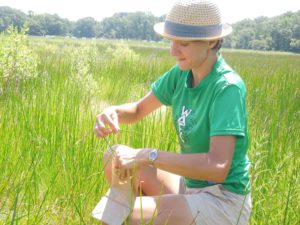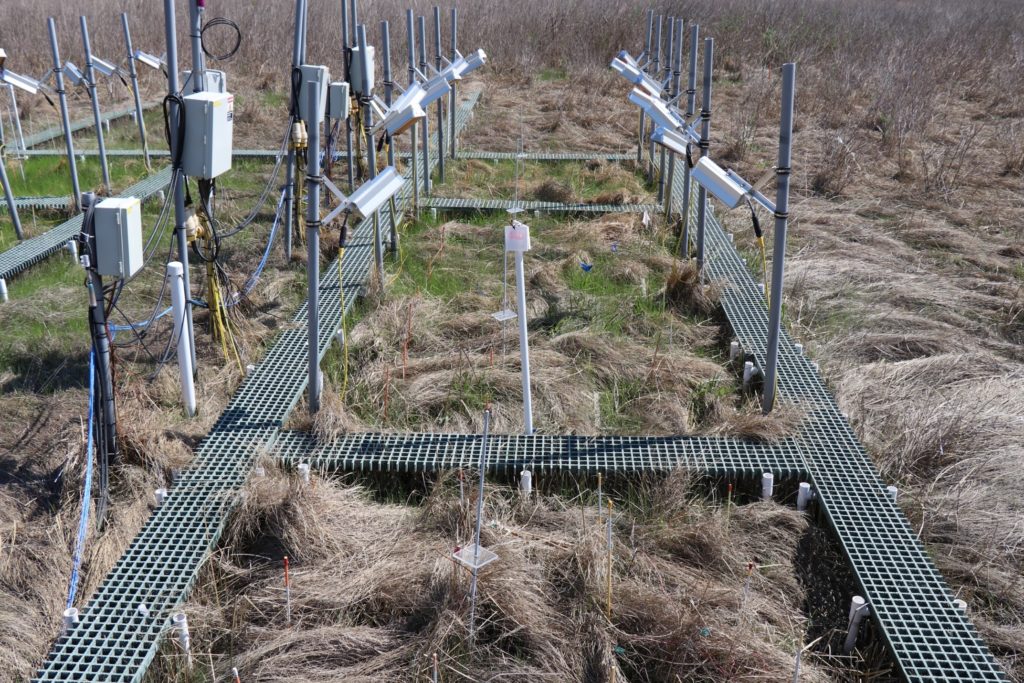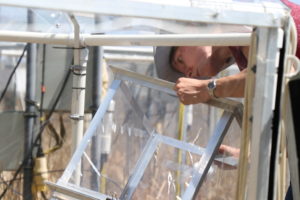SERC researchers race to find out how higher temps will affect coastal wetlands
by Mollie McNeel

Genevieve Noyce collects a blade of marsh sedge to measure in lab, in the Smithsonian’s “wetland of the future.”
(Kristen Minogue/SERC)
Wetlands are typically filled with the sounds of crickets chirping, bees buzzing and frogs croaking. But at the Smithsonian Environmental Research Center (SERC), those are all accompanied by the whirring of motor-powered pumps. These pumps are driving air from hexagonal carbon dioxide chambers to a greenhouse gas analyzer, helping scientists create a “wetland of the future.”
Scientists at SERC are attempting to predict how the warming climate and rising carbon dioxide levels will impact coastal wetlands with an experiment called SMARTX—Salt Marsh Accretion Response to Temperature eXperiment. It’s one of many futuristic experiments on the center’s Global Change Research Wetland.
“Wetlands are a really important part of our planet in terms of storing carbon, and we’re hoping to get an idea of how higher temperatures will affect them,” said Genevieve Noyce, an ecology postdoc at SERC, as she moved among grass-covered warming plots, measuring gas exchange over five-minute intervals.
As you weave your way along a series of boardwalks stretching into the 57-acre marsh, there are two noticeably different sections: one area dotted with space-like chambers and another with tall heat lamps facing each other in rows of grassy patches. Together, these two experiments form the only project of its kind examining how higher temperatures and higher carbon dioxide in the atmosphere affect tidal wetlands—vital ecosystems that act as buffers against sea-level rise, filters for pollutants and sponges for excess atmospheric carbon.
The infrared lamps overlook the warming experiment, currently entering its third summer of operation. Here, scientists are heating plots of grass to 1.7, 3.5 or 5.1 degrees Celsius over the current temperature, with some “natural” plots left alone to experience today’s temperatures. The Smithsonian team chose this range after scientists predicted that a temperature rise of 3 to 5 degrees Celsius (5.4 to 9 degrees Fahrenheit) could be the norm by 2100, if the burning of fossil fuels continues unabated. The experiment runs year-round, with lamps stretching overhead to warm the air above ground and pins diving a meter and a half (about four and a half feet) down to warm the soil.
“We can tell that it’s affecting how the plants grow,” said Noyce. “They are growing for longer during the year and that can affect carbon exchange—how much carbon dioxide they take up.”
Grasses in the plot warmed to 5.1 degrees hotter were the first to sprout this spring—emerging nearly a month before their neighboring natural grasses.

Infrared lamps and underground wires heat plots in the SMARTX experiment to different temperatures. The plots farther back experienced the biggest heat surge (5.1 degrees C hotter than normal) and turned green first. The front, with no lamps, didn’t receive any extra heat and are still brown in May. (Mollie McNeel)
But this experiment isn’t just looking at higher temps. Excess carbon dioxide is another factor to consider when looking towards our planet’s future. Right beside some of the warming plots, six see-through chambers made of PVC pipe and clear plastic wrapping dot the wetlands landscape. Each represents a section of marsh exposed to the carbon dioxide levels of the future. From the base of the pod, scientists pump in carbon dioxide to nearly double the concentration of today’s atmosphere. Three of the six chambers are also heated to 5.1 degrees Celsius (9 degrees Fahrenheit) above the current temperature, allowing scientists to see how both heat and higher carbon dioxide work in sync.
While this section of the project is only entering its second summer, it’s already shown some important results. Plants in the heated chambers are emitting more methane and staying green longer into the fall. They’re also putting more growth in their underground roots.

Genevieve Noyce sets up equipment for recording carbon dioxide and methane emissions. As carbon dioxide rises, plants develop more sprawling root systems. (Mollie McNeel)
Differences in root mass occur because with added carbon dioxide, plants need more nutrients such as nitrogen, which they get from the soil by growing sprawling root systems. But the roots mean more than nitrogen—for wetlands, more plant roots could mean the difference between life and death.
Having a strong and vast root system is vital to the survival of wetlands. As they are located on the coast, wetlands are on the front lines of flooding and sea level rise. Having more roots belowground helps the wetland build and maintain soil, possibly allowing it to “outpace” rising oceans and ultimately survive.
In today’s news, most predictions for our planet seem grim. But in the case of wetlands, higher carbon dioxide levels could help “shore up” their resistance to sea-level rise.
“It looks like, at least initially, the added carbon dioxide results in higher biomass, which could be a good thing for wetlands,” said Noyce. Only time will tell, though, as the added growth effect might wear off as plants and soil microbes adjust to the increased gasses.
Both the warming plots and carbon dioxide chambers act as windows for scientists to see the future of coastal wetlands. They’ve seen some definite changes, including plant growth, methane and carbon dioxide exchange between the soil, plants and roots. But there are still potential effects the researchers aren’t aware of.
“The change in vegetation is pretty striking,” said Noyce. “We definitely are altering the timing of when the vegetation is growing—when it starts, when it ends—and we don’t necessarily know all the things that are going to affect the cycle down the road. But I know you can’t change the vegetation that much without some sort of effect.”
Read more:
Cranking Up the Heat in the “Wetland of the Future”
Unsolved Mysteries: Rising Temps, Falling Marshes?
Wetlands Can Resist Rising Seas, If We Let Them
Six Reasons to Celebrate World Wetlands Day

